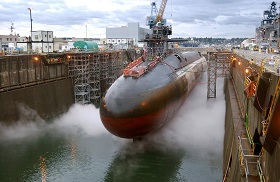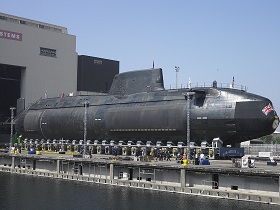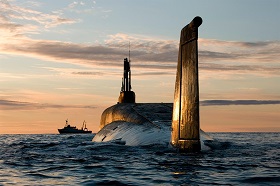Modernization of naval strategic nuclear forces, including nuclear powered ballistic missile submarines (SSBNs) and submarine-launched ballistic missiles (SLBMs), is a key strategic stability issue in the Russia-U.S. relationship. Whereas Russia launched the process quite a while ago and boasts three Project 955 submarines, the United States is only just developing its new SSBN. This article discusses the status of the American nuclear submarine program and problems it may face.
Top Priority
The most survivable component of the nuclear triad, the naval strategic nuclear force is the backbone of the U.S. nuclear juggernaut. According to the Congressional Research Service, by 2018 implementation of the START III Treaty will see SSBNs account for about 35 percent of total launchers and deployed launchers (280 out of 800 and 240 out of 700 respectively), as well as 70 percent of total warheads (1090 out of 1,550). SSBNs accounted for about 50 percent of total warheads (1,152 out of 2,152).
Today, the U.S. Navy has 14 Ohio-class SSBNs. Of them, 18 were built in 1976-1997, but in the 2000s four were converted into guided-missile submarines to carry Tomahawk cruise missiles. Each submarine has 24 SLBM tubes, although by 2018 the number is to be reduced to 20 through the deactivation of four tubes. All these submarines carry the Trident II D-5 SLBMs, and eight ships are deployed at Navy base Kitsap, Washington, on the Pacific coast, while the other six are at Kings Bay, Georgia, on the Atlantic.
Initially, the Ohio-class submarine’s service life was designed to be 30 years, but this was later extended to 42 years, with planned decommissioning in 2027-2040 at a rate of one SSBN a year. Since the completion cycle – from program launch to first combat duty – is quite lengthy, the issue of building a new generation vessel is fairly acute. To this end, Chief of Naval Operations Jonathan Greenert has repeatedly said that building a new-generation SSBN is a top priority for any scenario.
Ohio Replacement
The Ohio Replacement Program (ORP, initially SSBN(X) was launched in 2008, and so far is largely focused on a new submarine to carry the Trident II D-5, while a new SLBM seems to be an issue set aside for the distant future.
The United States plans to build 12 new missile submarines with a 42-year lifespan to replace the 14 SSBNs currently deployed. For nuclear deterrence missions, the U.S. Navy deems it necessary to have 10 combat ready submarines, i.e. 10 submarines out of repairs. Cutting the number from 14 to 12 should be possible by equipping new ships with a non-refueling nuclear power plant, which would reduce the mid-life overhaul period from four to two years.
For financial reasons, the U.S. Navy rescheduled the purchase of the leading ship from 2019 to 2012 financial year, so it is due to be commissioned in 2030 rather than in 2029 as had been planned. Consequently, over the period 2029-2041, the U.S. Navy will have only 10-11 SSBNs, but this was deemed acceptable because no protracted repairs are planned for that period. However, in contingencies, for example if there is an accident, the number of combat ready SSBNs could fall below the required level of 10-ships, and further delays in the construction program would be absolutely inadmissible.
According to publicly available information, the SSBN is being developed by the General Dynamics Electric Boat and is to have a displacement of 21,000 tons and 16 Trident II D-5 missile tubes. Notably, the Ohio-class is provided with eight more tubes but with a displacement 2,000 tons lower. Greater displacement is designed to raise operational security and reduce noise, including through full-scale electric propulsion. For maneuverability, the submarines will have X-shaped stern rudders and several systems similar to those installed on multipurpose Virginia-class submarines, including a jet propeller instead of standard screw propellers, a LAB wide-aperture forward hydroacoustic complex and hydroacoustic coating for partial absorption of enemy sonar radiation.
The Costs
The U.S. Navy estimates that construction of the new SSBN will cost USD 12.4 billion in 2014 prices, including USD 4.8 billion in one-off design expenditure. The average cost of follow-on submarines stands at USD 6 billion, but the Navy wants to cut this figure to USD 5.5 billion as had been envisaged in 2010 . Hence, the ORP scheme should total at least USD 72.9 billion over 15 years, whereas Russia’s overall expenses for naval construction in the 10-year State Weapons Program 2020 come to about USD 95 billion at the current exchange rate. And there is also the danger of safety parameters being reduced due to budget cuts.
The ORP’s huge price tag generates major risks for the entire fleet. According to the 2015 Annual Report to Congress on the Annual Long-range Plan for Construction of Naval Vessels, nuclear missile submarine construction will considerably affect all other shipbuilding programs, except for the legislatively protected aircraft carrier plans, because the SSBNs will devour up to 50 percent of the entire naval shipbuilding budget.
To rectify the situation, the Navy requests that Congress allocate and extra USD 4 billion for ORP annually over a 15 year period, stressing that SSBNs are to be built for handling the DoD-wide nuclear deterrence mission rather than for purely naval purposes.
Rear Admiral Richard Breckenridge, Director of the Undersea Warfare Division at the Department, told Congress that if the Navy receives only USD 2 billion each year, construction of 16 ships would have to be dropped, including four multipurpose submarines and four destroyers, and those figures would double if no extra funds are allocated.
The legislators are largely cooperative. In 2014, Congress supplemented the 2015 defense budget with an article on a separate National Sea-Based Deterrence Fund that so far remains on paper because the relevant moneys are earmarked for 2016 to the tune of USD 1.39 billion for R&D, meaning that no extra funds can be expected.
Congress also permits funds to be channeled towards this from other areas of DoD expenditure, while initially only the Navy Department budget could be tapped for these purposes. Hence, additional ORP financing can only come by reducing, postponing, or cancelling other defense programs.
The Navy may run into trouble even if the requested USD 60 billion is allocated. A Congressional Budget Office report indicates that the program should actually cost USD 92 billion, i.e. 26 percent above the target figure. The USD 10-15 billion earmarked for R&D is accounted for separately. Somewhat lower spending levels – USD 83.4 billion for the program and USD 11.7 billion for R&D – are projected by the Government Accountability Office. Needless to say, if the Damocles-sword-shaped sequester comes, financing for the ORP and other shipbuilding programs would become highly unfeasible.
British Participation
Looking at ORP, one cannot but mention cooperation between Washington and London in naval nuclear deterrence, which began over 50 year ago with the signing of the 1958 agreement on bilateral cooperation in the use of atomic energy for mutual defense.
The Royal Navy has four Vanguard-class SSBNs armed with American Trident II D5 missiles planned for decommissioning in the late 2020s-early 2030s. According to a UK Defence Ministry review of alternative scenarios for upgrading the strategic nuclear forces, the optimal path lies in building the new-generation SSBNs carrying Trident missiles. Plans provide for the construction of four submarines under the Successor program, although the final decision on their number is expected in 2016.
The Successor program somewhat overtakes ORP, with construction of the British leading missile submarine due to start in 2016 and its commissioning envisaged in 2028. London and Washington collaborate in several areas in modernizing the sea-based nuclear force. For example, the Americans help the British to develop the PWR-3 power plant.
American and British submarines will also have identical modular missile sections – 16 tubes in the American and eight tubes in the British versions. London is substantially financing R&D part.
High modernization costs, restricted use and other factors fuel the discussion on possible reduction of the UK’s nuclear arsenal or even its complete scrapping, although proponents of nuclear disarmament will hardly triumph as current plans are not subject to revision.
U.S. and British modernization programs for sea-based nuclear forces will be implemented, especially as the American program is less ambitious than the Russian version, and does not envision developing a new SSBN any time soon. The strategic nuclear force and its naval component remain a staple in Washington’s military planning.
However, military and especially political leaders seem to be in the midst of a long-standing fatigue when it comes to maintaining their nuclear potential. Since U.S. dominance in conventional weapons is balanced by the Russian and Chinese nuclear arsenals, the formally peace-loving Washington is advancing the Global Zero-style ideas, craving to dominate in a hypothetical non-nuclear world. However, nuclear disarmament remains pie in the sky, while the pragmatic U.S. top brass and the defense sector are working hard on a program to generate the basis for the American nuclear force until the late 2070s.







